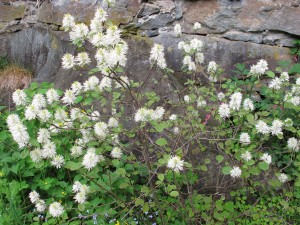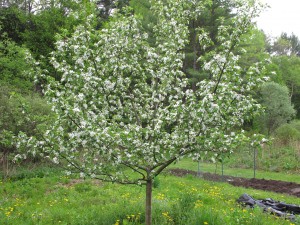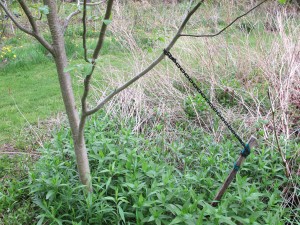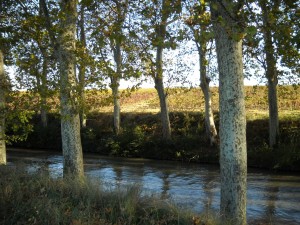Selecting and Training Flowering Trees
This has been a great year for flowering trees and shrubs. My Merrill magnolia had many hundreds of white blossoms in late April.
The crabapples everywhere put on a spectacular display this year. My fothergilla (a shrub with great fall leaf color) is in bloom now with its tidy white bottle-brush flowers. My ‘Olga Mezitt’ rhododendron (one of the parents of the popular PJM rhodie) is looking great and my wild azaleas are getting ready to bloom. And now the lilacs are blooming for me and I am overwhelmed with the large purple, blue, white and pink panicles (clusters of flowers). Spring has definitely sprung.
All these blooms this year will certainly encourage many gardeners to buy trees and shrubs and plant them. That’s a fine idea, but if you plant now, please remember that you must keep watering them all summer if we don’t get an inch or more of rain per week. When August comes around it will be easy to have your new tree dehydrate if you get lazy or forgetful.
New trees and shrubs need a year or more to grow roots sufficient for their needs if we get hot, dry weather. So if you are forgetful or will be doing lots of traveling, you might want to hold off on planting a new tree until fall, which is also a good time for planting. Fall is cooler and more likely to be rainy.
I like to buy flowering trees and shrubs when they’re in bloom. That allows me to see the color and check out the fragrance. But there is more than just the flowers to consider when selecting a good crabapple or magnolia. Let’s start with size and price. Bigger
is not necessarily better. If you are on life support and don’t expect to be around in 5 years, sure, buy the biggest tree you can afford. But be aware that a bigger tree is not only more expensive – it is also harder to plant and takes more water and care. A bigger tree may have a smaller proportion of its root system intact after being dug up and put in a pot than a small tree. I like to buy smaller specimens and then train them to be a nice shape. That’s harder to do on a larger tree.
I recently visited a nice new nursery run by Henderson’s Tree Service on Rte 14 in Hartford, Vermont. There I chatted with my friend Sylvia Provost who is co-owner of the business. I asked Sylvia what she would look for if purchasing a crabapple for herself. Without a moment’s hesitation she responded. “Structure,” she said.
What Sylvia was talking about is the shape of the tree and the placement of the branches. Fruit trees produce best on branches that leave the trunk at a right angle or are aiming just slightly upward. Branches that shoot straight up are not usually good fruit and blossom producers.
And although Sylvia noted that you can train a tree to be the shape you want, it is easier to start with something that is closer to your ideal before you start training. So, for example, Sylvia said that if you have a swimming pool some distance from your patio, you should choose a tree that has an open format, one that you can see through – and see what is happening at the pool. Conversely, if you have nosy neighbors and want to screen their view of your patio, you might select a tree that has a full, dense arrangement of branches.
Generally, pruning a tree should begin in the second year of its life at your home. I often see apple and crabapple trees that have very low branches. I like to prune off those low branches to make it easy to mow around, and to have a nicer look. And if two branches are both striving to be the “leader” or the dominant, tallest stem, I remove one. And although most books say you should prune fruit trees in March or April, you can safely make a few judicious cuts now to train your tree.
You may train branches to grow at different angles by weighing them down – if you do so soon. This is an activity for spring, starting before the new layer of cambium growth has occurred. You can drive a stake into the ground and tie a branch to it for the next 2 months. A branch the diameter of a finger can weighed down by hanging a plastic pop bottle on it, then filling it with water until it bends to the correct angle.
Chris Wilson of the EC Brown Nursery in Thetford, Vermont suggested that when buying a tree, look at leaf color – leaves should be green, not tinged with yellow. He also suggested making sure the tree has branches on all sides, and that the bark has not been damaged.
So if you’ve delighted in the flowers on trees in your neighborhood this year, go get one or more. Study several specimens to find the best one. And just remember to water all summer long!
Henry Homeyer is a gardener and garden designer living in Cornish flat, NH. His Web site is www.Gardening-Guy.com.
Lilacs
Chris Wilson loves lilacs. He grows about 200 of them including more than 100 varieties at his home in West Newbury, Vermont. Like many gardeners, he was a little disappointed with the showing of his lilacs this year. There were fewer blossoms, and many were smaller than normal. I recently met with Chris, who works at E.C. Brown’s Nursery in Thetford Center, Vermont to discuss lilacs – and this year’s less than stellar performance.
First, Chris noted that many lilacs tend to follow two-year cycles of abundant bloom. Like apple trees that produce a heavy fruit load, producing a heavy crop of blossoms and seeds draws down on the energy of a lilac; the next year the lilacs tend to be less productive. I understand that phenomenon, but can’t imagine that all lilacs everywhere would be on the same cycle. But it does make me want to cut off the spent flower panicles on my favorite lilacs before they expend all the energy of making seeds.
The next possibility that Chris and I discussed was the extreme variations of temperature this spring. The early heat caused buds to swell and prepare for opening. That was followed by several hard frosts. Some of the buds may well have been damaged or made more susceptible to fungal diseases that have also attacked some lilacs this spring. He showed me some blackened stems and buds that were blighted and unproductive.
I have noticed that later-blooming lilacs are doing better than the earlier blooming lilacs did. That would make sense. Later blooming lilacs probably would not have buds that were ready to open during a week of high temperatures. Miss Kim, for example, is a very popular later-blooming lilac that is blooming quite well for me.
But my personal theory, unsubstantiated by any independent tests, is this: Last August was cool and rainy. I have read that lilacs set their spring buds in late summer, which I define as August- though the literature does not specify. I think that since lilacs got less sun than usual, they didn’t set as many buds. Then the hot/cold/hot weather this spring reduced even those numbers. And who knows what the lack of snow meant to lilacs. Gardening is full of unanswerable questions.
Conventional wisdom has it that lilacs need a top-dressing of ashes from the woodstove (or a dose of limestone from your local feed-n-grain store) each March. I disagree. Yes, lilacs do best in neutral or slightly sweet (alkaline) soil. For most of us, that means counteracting our acid rain by applying lime or wood ash once a year. But March? I think the timing has more to do with when farmers of past years were not too busy and had the time to spread some ashes. I believe that any time of year is just fine. It takes time for limestone to be incorporated into the soil. The key is to do it annually. I spread two quarts of wood ashes around a big lilac – whenever I get a chance. Do it now, before you forget. It really will make a difference next year.
Lilacs need annual pruning in order to look good. Most lilacs sucker, or send up new shoots from the roots. If you do not cut some of these back to the ground, the clump will get wider and wider. One way to keep your lilac vigorous is to remove a couple of the older stems each year, allowing the smaller and middle-sized stems to get larger. And unless you want to get on a ladder to cut blooms, you need to control height. Cut back tall stems to a fork, reducing height. The time to do it? Now, after the blossoms have finished.
It is often difficult to prune back stems to the ground as lilac stems grow very close to each other. But if you only cut back a stem to 2 or 3 feet above ground, you are left with stubs that are unsightly and that will sprout new shoots – often several new ones – that will clog up the center of the shrub more than the stem you cut off. My weapon of choice is a folding saw with a pointy end. I get on my knees and work the point into the clump as near the base as possible, and saw through a big stem. It takes time and energy, but is worth it.
After all the standard lilacs have finished blooming comes the show put on by Japanese tree lilacs. These are medium-sized trees, not shrubs. They have white flowers that are quite fragrant. But they may be invasive: the personnel at the Saint Gaudens National Historic Site in Cornish, NH, have found lots of young tree lilacs in the woods, and at the edge of the woods near their site. They have started pulling them as they decided that these visitors from the Far East have the potential to take over the understory. They are not, however, listed on any invasive species lists of prohibited plants.
The standard lilac is a wondrous plant. When I cross-country ski I sometimes see them by cellar holes of homes abandoned a century or more ago. Their flowers are beautiful and fragrant. What more could I we ask for?
Henry Homeyer is the author of 4 gardening books. His Web site is www.Gardening-guy.com.
Pollarding Trees
On a recent trip to southern France I was fascinated by what some people might term “tree abuse”. The French love to turn certain trees into sculpted forms by removing all new growth each year – or most, depending on the age of the tree. The English term for this type of pruning is “pollarding”. I have decided I shall give it a try.
The English plane tree (Platanus x. acerifolia) is the most commonly pollarded tree in southern France, though I have seen other fast-growing trees treated the same way, notably lindens (Tilia spp). Plane trees are reminiscent of our sycamores (Platanus occidentalis), with bark that looks a bit like the patterns and colors of camouflage clothing. They are commonly used to line city streets and rural lanes.
The plane tree is fast growing and survives in most places – even along the Canal du Midi, the seventeenth-century canal that connects the Mediterranean to the Atlantic. I spent a day biking the canal and was amazed to see plane tree roots cross the towpath and reach into the water – like pythons slithering out of the earth and into the canal. But I noticed that the plane tree sheds branches freely, dropping small branches onto my path. I gather it is a somewhat weak-wooded tree, though perhaps not as weak as our willows (Salix spp.) or box elder (Acer negundo).
Driving through the town of Puisserguier, in the Languedoc, I admired the ‘allees’ or rows of plane trees that lined their streets. Then one day I came back and saw that all new growth had been cut off, creating an eerie, Edward Gorey-like atmosphere. Workers with a boom truck were just finishing up a major task, clearing out the clutter by cutting off all the upper branches.
These big trees showed huge knobs, scars where this had been done many times. I spoke to a tree specialist, who explained that plane tree branches can grow 6-9 feet per year, so they cut off all new growth on mature trees every other year. By cutting back the smaller branches to the trunk or a major branch, much weak wood is eliminated and weight taken off the major branches. It keeps trees from getting too tall. And it creates wonderful sculpture.
Another benefit of pollarding a tree is that it creates dense shade. Cutting back the trees encourages them to send out multiple shoots. From the scarred knobs created in previous years, a half dozen branches will erupt. That creates dense foliage. The Mediterranean sun is hot in summer, and town squares are generally shaded from its intensity by pollarded plane trees, much as our American elms once shaded Main Street.
When I return from France I will experiment with my seven-sons flower tree (Heptacodium micinioides). This is a fast-growing tree that blooms in the fall; the blossoms are small, white and lightly fragrant. It is originally from China, and has only started to become popular in the nursery trade in the last 20 years. I got mine about 10 years ago at EC Brown Nursery in Thetford, Vermont (www.ecbrownsnursery.com).
It is a medium-sized tree – the largest specimen I’ve seen is about 30 feet tall. But it can send up shoots 6 feet in a year, and I have struggled to keep mine the size and shape I want. It is near the house and several times it has attempted to send shoots indoors through a second-floor window. So I have pruned it hard, but never removed enough branches to create a pollarded look. The main trunk is now about 4-inches or more in diameter and 10 feet tall. It has one major bifurcation – where the trunk branches into 2 major branches. So I will cut off all the branches back to those two branches. Later, I may let a single new stem continue to grow and thicken, creating a higher point for pollarding.
So what else have I learned in France? I think I pamper some of my plants too much. I know that thyme, rosemary and lavender thrive in lean soil that is low in fertility. But it is hard for me to deny them some compost at planting time. Off-road biking here I have found them growing wild – thriving – in sandy dry soil, which should be a lesson to me.
Similarly, grapes here do fabulously in dry, rocky soil. One vintner, an organic grower at Domaine Bordes (A.O.C. Saint Chinian) told me that he uses no fertilizer. He said that his grapes do just fine, producing great flavor – but in smaller quantities than conventional growers who use chemical fertilizers. Grape growers often mulch with gravel in France, a technique I haven’t yet tried.
Lastly, I saw sheep’s wool used as mulch around trees. There is not much market for raw wool in France – or in the States. If you have a friend with sheep or llamas, you might be able to get some wool. It will keep down weeds, hold in moisture, and slowly break down, providing some nitrogen. Still, I’m not sure I like the look – perhaps it would be good in my blackberry patch, or around apple trees that are not in view every day.
So if you travel, observe. And send me your observations – we can all learn new techniques from each other, and from different cultures.
Contact Henry at henry.homeyer@comcast.net or P.O. Box 364, Cornish Flat, NH 03746.








